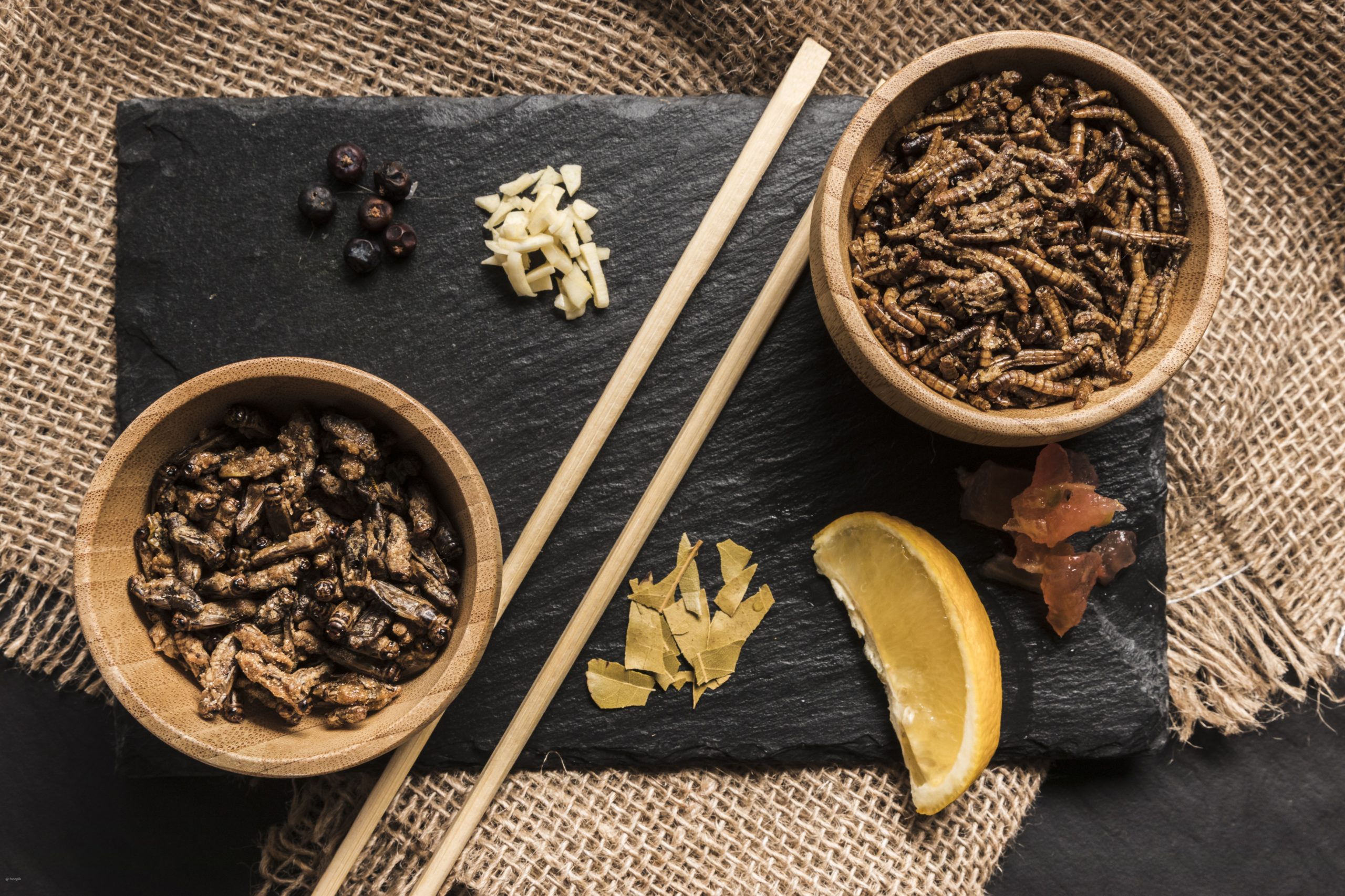Chitin
Worms - New Food for a New Man in the New Deal! It sounds like an advertising slogan, but it does not bode well for humanity's bright future.
The mainstream media is pumping up the topic of “food” made from insects. The topic is not new at all, because it's been more or less 2 years since "the European Food Safety Authority (EFSA) issued a positive opinion on the mealworm larva as a new food product" , but apparently the higher forces decided that it was time to leave to people with the idea of changing their diet, because our current habits are burdened with too large a carbon footprint, and as we know (or at least it should) we are on the eve of introducing a carbon passport, which is another way to implement prohibitions and orders in the awareness of society, which will have to accept for a better life… for everyone.
Food products made from insects are promoted as modern and ecological, but is it healthy? For the last 2 years, an exam for the societies of developed countries on how one should take care of one's health has been taking place - in my opinion, it was a concert, but we would like to live in a society of conscious people, which is why we publish information for you on chitin (which is made of, among others, insect shells), sent by our Reader, which are worth getting acquainted with even if you are not a scientist.
We give the floor to the author of the next part of the article…
Below are just some observations and conclusions drawn from publications studying chitin and its derivatives.
Medium-sized chitin (40-70 µm) stimulates macrophage IL-17A production and IL-17A receptor expression through a pathway that involves TLR-2 and MyD88, resulting in acute inflammation.
Pathways that included TLR-2, dectin-1 and nuclear factor NF-κB mediated the effects of medium-sized chitin. In contrast, the effects of small-sized chitin were mediated by pathways that involved the mannose receptor and splenic tyrosine kinase (Syk).
Chitin contains size-dependent pathogen-associated molecular patterns that stimulate TLR-2, dectin-1, and the mannose receptor; which differentially activate NF-κB and Syk; and which stimulate the production of pro- and anti-inflammatory cytokines.
Recently, studies have shown that 40-70 µm chitin is a multifaceted adjuvant for Th2 (bad), Th1 and Th17 (bad) responses.
Chitin elicits different host responses depending on its size, the nature of the chitin, methods of preparation, time and route of administration.
When 5 mg of chitin was injected intraperitoneally every 2 weeks for a period of 12 weeks, the mice were phenotypically normal, but histologically, many macrophages were observed with hyperplasia in the mesentery, and polykaryocyte-like cells (!!!) with foreign bodies in the spleen.
When 5 mg of chitosan was injected intraperitoneally, the body weight of the mice decreased significantly, and in the fifth week the mice were inactive. Conversely, the administration of 5% chitosan in a casein (protein, e.g. cheese) diet resulted in a decrease in the body weight of the mice, as well as a reduction in the number of Bifidobacterium and Lactobacillus in the normal flora of the digestive tract.
Chitosan promotes cancer progression and generation of stem cell characteristics in colon cancer and hepatocellular carcinoma cells.
Chitin is a key ingredient in insects, fungi and house dust mites. Lower life forms are equipped with chitinases to defend themselves against chitin-containing pathogens. Humans also express chitinases, but also chitinase-like proteins that modulate immune responses. In particular, elevated levels of the chitinase-like protein YKL-40 are associated with severe asthma and cystic fibrosis.
Chitinases and chitinase-like proteins (CLPs) belong to the family of glycosidic hydrolases 18 (GH18). Chitinases are expressed in mammals and lower organisms and facilitate the degradation of chitin, hence they function as host defense enzymes.
Gene duplication and mutations resulting in loss of enzymatic function of active chitinases have resulted in the expression of a diverse range of CLPs in different species.
CLPs are genes increasingly associated with inflammation and tissue remodeling, not only in mammals but also in distant species.
CLPs have important regulatory functions in innate immune response pathways in host defense, tissue injury/repair, but also have extensive implications in the pathology of disease-related processes such as asthma.
—
The glycoside hydrolase family 18 (GH18) proteins include enzymatically active chitinases and enzymatically inactive chitinase-like proteins (CLPs). Chitinases hydrolyze the glycosidic bonds of chitin - a polysaccharide found as a structural component of the cell wall of fungi and bacteria and inside the exoskeleton of crustaceans, arthropods and helminths.
In insects, chitin is an integral part of the cuticle and the expression of chitinases is necessary for successful moulting and reorganization of the chitin-extracellular matrix architecture (insect tissues are attached from the inside to the "shell" and for the insect to be able to grow while going through the moult - chitinases must remodel the woven and its connection with the chitin shell).
CLP, on the other hand, is a diverse family of proteins often expressed in a species-specific manner and arose from duplication of the chitinase genes by mutation and loss of function of the chitinolytic domain (the domain that catalyzes the breakdown of chitin). CLPs are strongly, but not exclusively, associated with T-helper type 2 (Th2-type response) inflammatory pathologies, which include helminth infection, asthma, and fibrosis.
CLPs are evolving at an extremely rapid rate that seems to be beyond the scope of natural genetic drift, and rather indicative of positive selection forces driving their genetic variability.
This is generally a concern for molecular biologists, but not for physicians, who are largely ignorant of evolution at the molecular level. The point is that such positive pressure on adaptive evolution appears under the influence of a factor, which in the case of e.g. COVID vaccines is mmRNA, and in the case of CLP proteins, or rather their genes - chitin. The constant presence of chitin in food may lead to the acceleration of the evolution of genes encoding CLP proteins, which in turn may intensify pathological processes in which these proteins are involved, such as asthma.
All mammalian CLPs are extensively associated with immunomodulatory activities important in both combating pathogens and inducing host pathology. CLP expression is eg detected in arthritis and osteoarthritis and in inflammation of the airways. Increased levels of CLP expression are also found in infections, fibrosis, multiple sclerosis and various lung diseases. CLPs are also expressed in neutrophils and their expression is increased upon stimulation with IL-4/IL-13 and IFNγ.
Currently, research is aimed at using CLPs as indicators of pathology and/or stage of disease because the molecular mechanisms mediated by CLP proteins - which have been discovered so far - support a variety of functions of CLPs, ranging from changes in collagen synthesis/degradation to regulation of cytokine levels pro-inflammatory substances important for the course of infection.
CLP expression is strongly upregulated in the lungs of asthmatic patients and in mouse models of allergic airway inflammation. Most studies have focused on CLPs as modulators of the adaptive Th2 response during inflammation.
However, CLP expression also positively correlates with neutrophil- and IL-17-induced inflammation in asthma patients, suggesting that CLPs may also be important for non-Th2 asthma phenotypes, which are often further strongly associated with innate immune responses. This is further supported by the observation that CLPs stimulate the secretion of the cytokine IL-1β towards the production of interleukin IL-17A in innate γδ T cells, which results in the accumulation of neutrophils (e.g. in the lungs).
This effect of CLP on IL-1β probably occurs through the activation of the inflammasome [ similarly, protein S activates the inflammasome, resulting in, for example, the death of blood stem cells. In addition, severe COVID-19 is associated with the so-called "cytokine storm", which is a dramatic increase in inflammatory cytokines/chemokines especially IL-1β, IL-6, IL-8 and TNF-α] . Additionally, CLP levels positively correlate with IL-1β expression after brain injury.
Increased CLP levels are not solely attributed to pathogen-induced injury, as CLPs are also upregulated during sterile injuries, suggesting a fundamental role for CLPs in tissue repair. In general, research shows that CLPs play a dual role in tissue injury and tissue repair. On the one hand, they can promote rapid lung regeneration by influencing the production of Th2 cytokines during N. brasiliensis infection, and on the other hand, they can contribute to the generation of severe lung damage.
Biologically, this would mean that their resultant role depends on the presence - perhaps temporary, related to the time of action - of a stimulating factor, which may be chitin. In other words, its low presence in the tissue would promote the positive effects of CLP, and its increased prolonged presence would promote the negative effects of CLP - however, this is only speculation at this stage of CLP knowledge.
CLPs can also affect the Extra-Cellular Matrix (ECM) through direct interactions with ECM molecules, including collagen and heparan sulfate proteo-glycan. CLPs are also mitogenic for fibroblasts - they induce skin cell division. CLPs can induce cellular responses directly leading to increased collagen production and, consequently, stimulation of the formation of collagen fibroses, additionally inhibiting collagen degradation, which correlates, for example, with fibrotic disorders of the lungs and liver.
More importantly, CLP also regulates the so-called Endothelial-to-Mesenchymal Transition (EMT) – a process that involves a phenotypic change of epithelial cells towards a fibroblast-like mesenchymal cell that is highly migratory and secretes increased amounts of ECM (extracellular matrix) proteins such as eg collagen. EMT is not only a critical mechanism for cancer metastasis but has also been shown to be a key factor in airway remodeling in asthma.
There are also other molecular mechanisms in which chitin and its modified derivatives present in food may be involved, and which may significantly affect human pathophysiology, especially in terms of interaction with pathogens. Perhaps we will write about them another time.
Now it is necessary to realize that the constant presence of chitin in the human body as a result of its daily consumption in staple foods has never taken place before, especially in the Western world - thus the effects are unpredictable and political decisions approving such a state of affairs should be treated as another experiment politicians on people's health and lives.
The current policy has a great chance to lead to a drastic dysregulation of the entire molecular homeostasis of the cell in humans and the disappearance of ecological barriers between pathogens. Biologically, there can be only one consequence of this - a sharp increase in many diseases and deaths.


